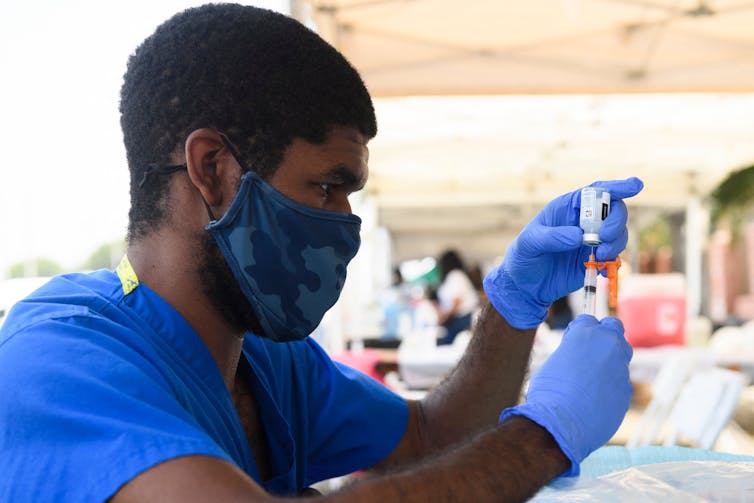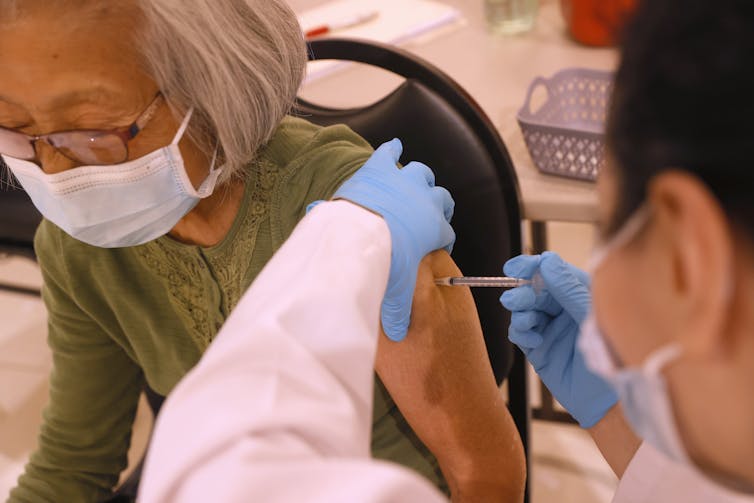
Experts in autocracies have pointed out that it is, unfortunately, easy to slip into normalizing the tyrant, hence it is important to hang on to outrage. These incidents which seem to call for the efforts of the Greek Furies (Erinyes) to come and deal with them will, I hope, help with that. As a reminder, though no one really knows how many there were supposed to be, the three names we have are Alecto, Megaera, and Tisiphone. These roughly translate as “unceasing,” “grudging,” and “vengeful destruction.”
I know everyone is wondering whether – not when – the current coronavirus, including the Delta variant, will ever go away. Well, the answer to that is no, it won’t. It wll likely become easier to deal with, but it’s unlikely to go away. The most likely outcome is that it will become like seasonal flu in that it will continue to change a little and new vaccines will be needed every year. And, as now happens with the flu, every year people will die from it – although not in the kind of numbers we are currently looking at.
================================================================
Is COVID-19 here to stay? A team of biologists explains what it means for a virus to become endemic

Patrick T. Fallon/AFP via Getty Images
Sara Sawyer, University of Colorado Boulder; Arturo Barbachano-Guerrero, University of Colorado Boulder, and Cody Warren, University of Colorado Boulder
Now that kids ages 5 to 11 are eligible for COVID-19 vaccination and the number of fully vaccinated people in the U.S. is rising, many people may be wondering what the endgame is for COVID-19.
Early on in the pandemic, it wasn’t unreasonable to expect that SARS-CoV-2 (the virus that causes COVID-19) might just go away, since historically some pandemic viruses have simply disappeared.
For instance, SARS-CoV, the coronavirus responsible for the first SARS pandemic in 2003, spread to 29 countries and regions, infecting more than 8,000 people from November 2002 to July 2003. But thanks to quick and effective public health interventions, SARS-CoV hasn’t been observed in humans in almost 20 years and is now considered extinct.
On the other hand, pandemic viruses may also gradually settle into a relatively stable rate of occurrence, maintaining a constant pool of infected hosts capable of spreading the virus to others. These viruses are said to be “endemic.”
Examples of endemic viruses in the United States include those that cause the common cold and the seasonal flu that appear year after year. Much like these, the virus that causes COVID-19 likely won’t die out, and most experts now expect it to become endemic.
We are a team of virologists and immunologists from the University of Colorado Boulder studying animal viruses that infect humans. An essential focus of our research is to identify and describe the key adaptations that animal viruses require to persist in the human population.
What determines which viruses become endemic?
So why did the first SARS virus from 2003 (SARS-CoV) go extinct while this one (SARS-CoV-2) may become endemic?
The ultimate fate of a virus depends on how well it maintains its transmission. Generally speaking, viruses that are highly contagious, meaning that they spread really well from one person to the next, may never die out on their own because they are so good at finding new people to infect.
When a virus first enters a population with no immunity, its contagiousness is defined by scientists using a simple mathematical term, called R0, which is pronounced “R-naught.” This is also referred to as the reproduction number. The reproduction number of a virus represents how many people, on average, are infected by each infected person. For example, the first SARS-CoV had an R0 of about 2, meaning that each infected person passes the virus to two people on average. For the delta variant strain of SARS-CoV-2, the R0 is between 6 and 7.
The goal for public health authorities is to slow the rate by which viruses spread. Universal masking, social distancing, contact tracing and quarantines are all effective tools to reduce the spread of respiratory viruses. Since SARS-CoV was poorly transmissible, it just took a little bit of public health intervention to drive the virus to extinction. Given the highly transmissible nature of the delta variant, the challenge for eliminating the virus will be much greater, meaning that the virus is more likely to become endemic.

Bryan R. Smith/AFP via Getty Images
Is COVID-19 ever going away?
It’s clear that SARS-CoV-2 is very successful at finding new people to infect, and that people can get infected after vaccination. For these reasons, the transmission of this virus is not expected to end. It’s important that we consider why SARS-CoV-2 moves so easily from one person to the next, and how human behavior plays into that virus transmission.
SARS-CoV-2 is a respiratory virus that is spread through the air and is efficiently transmitted when people congregate. Critical public health interventions, like mask use and social distancing, have been key in slowing the spread of disease. However, any lapse in these public health measures can have dire consequences. For instance, a 2020 motorcycle rally brought together nearly 500,000 people in Sturgis, South Dakota, during the early phases of the pandemic. Most of the attendees were unmasked and not practicing social distancing. That event was directly responsible for an increase in COVID-19 cases in the state of South Dakota and nationwide. This shows how easily the virus can spread when people let their guard down.
The virus that causes COVID-19 is often associated with superspreading events, in which many people are infected all at once, typically by a single infected individual. In fact, our own work has shown that just 2% of the people infected with COVID-19 carry 90% of the virus that is circulating in a community. These important “supercarriers” have a disproportionately large impact on infecting others, and if they aren’t tracked down before they spread the virus to the next person, they will continue to sustain the epidemic. We currently don’t have a nationwide screening program geared toward identifying these individuals.
Finally, asymptomatically infected people account for roughly half of all infections of COVID-19. This, when coupled with a broad range of time in which people can be infectious – two days before and 10 days after symptoms appear – affords many opportunities for virus transmission, since people who don’t know they are sick generally take few measures to isolate from others.
The contagious nature of SARS-CoV-2 and our highly interconnected society constitute a perfect storm that will likely contribute to sustained virus spread.

Justin Sullivan/Getty Images News via Getty Images
What will our future with COVID-19 look like?
Given the considerations discussed above and what we know about COVID-19 so far, many scientists believe that the virus that causes COVID-19 will likely settle into endemic patterns of transmission. But our inability to eradicate the virus does not mean that all hope is lost.
Our post-pandemic future will heavily depend on how the virus evolves over the coming years. SARS-CoV-2 is a completely new human virus that is still adapting to its new host. Over time, we may see the virus become less pathogenic, similar to the four coronaviruses that cause the common cold, which represent little more than a seasonal nuisance.
Global vaccination programs will have the greatest impact on curbing new cases of the disease. However, the SARS-CoV-2 vaccine campaign so far has touched only a small percentage of people on the planet. In addition, breakthrough infections in vaccinated people still occur because no vaccine is 100% effective. This means that booster shots will likely be needed to maximize vaccine-induced protection against infection.
With global virus surveillance and the speed at which safe and effective vaccines have been developed, we are well poised to tackle the ever-evolving target that is SARS-CoV-2. Influenza is endemic and evolves quickly, but seasonal vaccination enables life to go on as normal. We can expect the same for SARS-CoV-2 – eventually.
How will we know if and when SARS-CoV-2 becomes endemic?
Four seasonal coronaviruses circulate in humans endemically already. They tend to recur annually, usually during the winter months, and affect children more than adults. The virus that causes COVID-19 has not yet settled down into these predictable patterns and instead is flaring up unpredictably around the globe in ways that are sometimes difficult to predict.
[Over 115,000 readers rely on The Conversation’s newsletter to understand the world. Sign up today.]
Once rates of SARS-CoV-2 stabilize, we can call it endemic. But this transition may look different based on where you are in the world. For instance, countries with high vaccine coverage and plentiful boosters may soon settle into predictable spikes of COVID-19 during the winter months when the environmental conditions are more favorable to virus transmission. In contrast, unpredictable epidemics may persist in regions with lower vaccination rates.![]()
Sara Sawyer, Professor of Molecular, Cellular and Developmental Biology, University of Colorado Boulder; Arturo Barbachano-Guerrero, Postdoctoral Researcher in Virology, University of Colorado Boulder, and Cody Warren, Postdoctoral Fellow in Virology and Immunology, University of Colorado Boulder
This article is republished from The Conversation under a Creative Commons license. Read the original article.
================================================================
Alecto, Megaera, and Tisiphone, could this virus have been prevented from becoming endemic? The authors are careful not to address that or even allude to it. But from what they do say about the handling of the 2002-2003 outbreak, my guess is yes, it could have. Our president at that time was George W Bush. I seriously doubt he knows or knew more than Trump** about science ot public health or viruses. But what he did know was how to shut up and let his people do their jobs, and to back them up, and to not make everything about himself. I am inclined to believe that, if we had had President H. Clinton in 2020, the handling of the pandemic would have been such that the virus could have been made extinct. Of course, that is not provable – hypotheticals seldom are.
The Furies and I will be back.
6 Responses to “Everyday Erinyes #291”
Sorry, the comment form is closed at this time.

Thanks Joanne–a solid explanation that should be easy to understand (if one believes science at all). Also a good reason to push for the waivers on patents, especially with Moderna created at our taxpayer expense, to allow manufacturing in other countries to increase vaccination rates and reduce the opportunities to change and become more virulent, etc.
I am not an expert, but I do think that Covid-19 or Sars-CoV-2 will be here with us forever….and we will need at least annual flu and covid vaccines…..and to be smart…..fortunately, there do seem to be some oral treatments coming through that might be usable in a primary care (or urgent care or ER) setting for early infections…
Very informative! I thoroughly appreciate your sharing this one.
Great article, Joanne.
I appreciate all of the information it details regarding various viruses and how they end up becoming an epidemic like Covid-19 did in 2020 and still is,
Wish the way it continue creating new variants, scares me. I too have a feeling that it will become a vaccine that we may need to get yearly or every two years to be safe.
I just wish the unvaccinated, would get their shots. so we can get more control of this life killing virus.
Honestly, the variants scare me too. The only thing between me and panic is that killing off hostswithout whom tou cannot reproduce is not the best evolutionary strategy. Estivating, and then coming out when it gets chilly, is much more effective.
Thanks for sharing this article, Joanne. I also believe that COVID-19 is here to stay, transforming itself in due time to something less lethal like a flu virus. But that will take time; usually, these viruses go through a phase mutating into even more contagious and virulent (pun deliberate) versions, as we now see with the Delta variant.
To keep COVID-19 from evolving into even nastier strains and wreakinh havoc, maximising worldwide vaccination is essential.